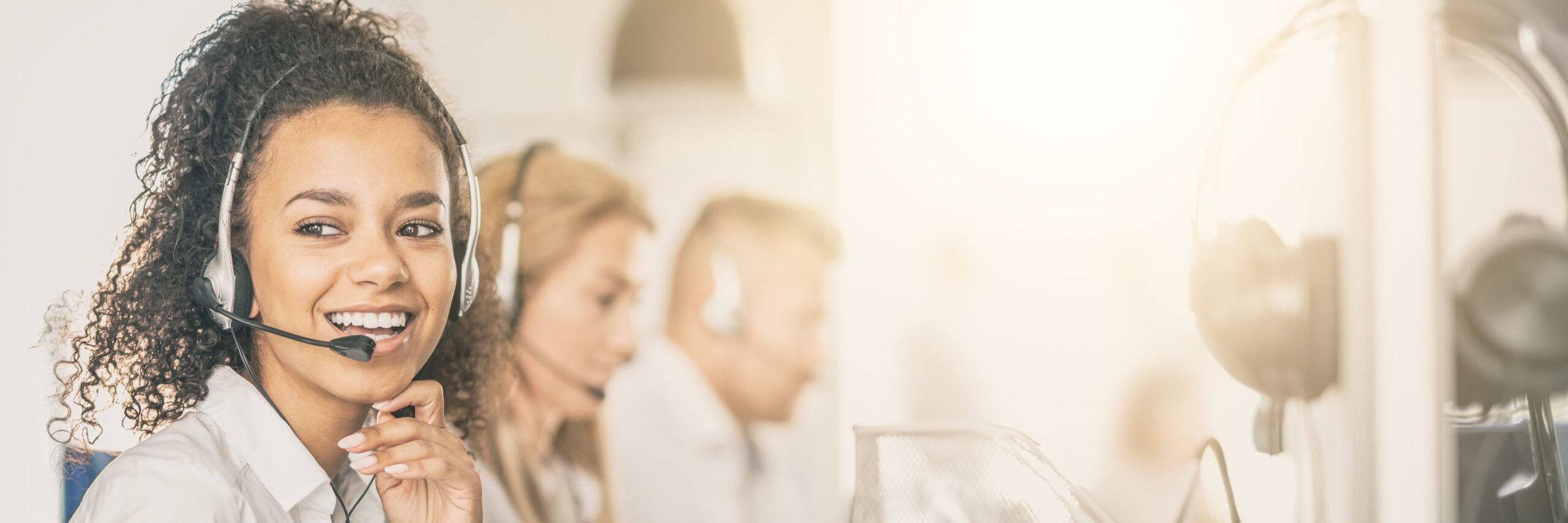How to Become a Contact Tracer
Why Trust EduMed? We partner with 150+ nursing & allied health professionals to bring you the most in-depth data & insights on higher education & careers in healthcare. Meet our team and review our editorial values.
Contact tracing is one of the most important weapons available in the fight against COVID-19. Learn what a contact tracer is and how you can become one.

It’s been nearly a year since the COVID-19 pandemic changed everyday life in the U.S. The disease is still spreading and devastating thousands of lives. U.S. citizens have been given basic public health guidelines to help stop the spread, but healthcare workers are on the front lines of this fight.
Even if you haven’t worked in healthcare, there is a way for you to make a significant impact on the spread of COVID-19 by learning how to become a contact tracer. As you can imagine, contact tracers are in high demand right now.
When a community is dealing with an outbreak of any infectious disease, contact tracing is an essential step in stopping the spread. A mathematical model on the spread of COVID-19 by the Centers for Disease Control and Prevention indicates that contact tracing and quarantine could reduce transmission by 60% if proper follow up is done within 4.5 days.
While contact tracing is an integral part of public health, contact tracers do not necessarily need education or experience in the public health field. Read on to learn how to become a contact tracer, what skills you need, and how to get hired and begin this rewarding work.
FIND PROGRAMS NEAR YOU:
STEP 1
Learn How Contact Tracing Works
Contact tracing is an essential step in any public health response to an infectious disease. It identifies, monitors, and supports individuals who have a confirmed or probable diagnosis. The goals of contact tracing are to:
- Break the chain of transmission in a disease outbreak.
- Prevent local surges in the number of patients, which protects hospitals from becoming overwhelmed with patients and enables them to manage limited resources.
- Allow communities to quickly “get back to normal” by reopening schools, businesses, and other public areas.
The process begins when clinics, labs, and hospitals send local health departments the names of people recently diagnosed with the disease. In the case of COVID-19, a contact tracer will immediately contact the infected person and encourage them to isolate. They also work with the person to determine if they were in close contact with others while contagious. Often one of the close contacts is someone that the infected person doesn’t know by name, like a grocery store cashier. In that case, the contact tracer will ask questions (such as a physical description) to determine the contact’s identity. The contact tracer then notifies these close contacts while keeping the identity of the infected person confidential.
The contact tracer asks close contacts if they are experiencing symptoms and recommends testing. The contact tracer also offers advice on preventing transmission to others, such as self-quarantine and social distancing. They ask the close contacts to monitor any symptoms and alert the health department if symptoms develop. The contact tracer may ask them to take their temperature twice daily and provide the health department with daily updates on their condition.
Resources
These additional resources can assist you in your research on contact tracing and how it works.
- A Bureau of Labor Statistics interview with an epidemiologist who works as a contact tracer. She discusses her daily routine and why she loves the work.
- In-depth information on COVID-19 contact tracing goals, priorities, and steps from the Centers for Disease Control and Prevention (CDC). It includes a useful chart to help you visualize the contact tracing process.
- The CDC outlines the contact tracing job description, including essential functions, work environment, physical requirements, and required qualifications to become a contact tracer.
- Johns Hopkins University offers a Q&A with one of the developers of its online contact tracing course. He has worked as a COVID-19 contact tracer and outlines the basics of the job and discusses a typical workday.
- Prevent Epidemics, a project run by Resolve to Save Lives, shows you how to become a contact tracer by giving you step-by-step contact tracing protocols. It charts out the entire process from starting a case to closing it. The information also provides examples of the type of support contact tracers may need to offer infected individuals.
STEP 2
Develop the Right Skills
To become an effective contact tracer, you need proper training. There are several online courses available to teach you how to become a contact tracer. The Johns Hopkins Bloomberg School of Public Health offers a free seven-hour online course. The course covers:
- Facts about COVID-19 infection.
- Identifying an infectious contact.
- Creating a public health intervention timeline.
- Case investigation, including how to overcome communication barriers.
- Ethical considerations for contact tracing, isolation, and quarantine.
However, good contact tracers need more than public health training. They require empathy and people skills. Contact tracing is an interpersonal activity. Contact tracers ask for personal information and help people recall mundane details. They need to be creative and have good interviewing skills. This includes being good listeners and be able to synthesize information accurately. They must be kind while also being persistent.
Contact tracers help people in a stressful situation. The human element and personal interaction are critical to success.
Resources
These additional resources should assist you in gaining the skills and training needed to become an effective contact tracer:
- This free online contact tracing course offered by the Association of State and Territorial Health Officials focuses on remote contact tracing.
- The CDC offers COVID-19 contact tracing training resources. The resources include training modules, training scenarios, and additional readings.
- Johns Hopkins University offers online contact tracing course. You can view the syllabus, the instructor, read reviews, and enroll in the course.
- National Geographic has published an article on the history of contact tracing and the challenges that contact tracers face during COVID-19. The article includes interviews with contact tracers who speak about their experiences.
- The Public Health Foundation in coordination with the CDC Foundation COVID-19 Corps presents a preview of a developed by the Public Health Foundation in coordination with the CDC Foundation COVID-19 Corps. The preview includes helpful readings, data trackers, and course information.
STEP 3
Look for Contact Tracing Jobs
Once you have training in how to become a contact tracer, you’ll need to know where to look for work. In the United States, state and municipal Departments of Health (DOH) run most COVID-19 contact tracing programs. However, many DOH use employment agencies to find contact tracers or contact the work out to consulting firms in a public/private partnership. For instance, Massachusetts contacts with an organization called Partners In Health to run its contact tracing program.
Each state and municipality staffs its program differently. You may want to start your employment search by contacting your local health department to see how it runs its contact tracing program. Job sites like Indeed or career networking sites like LinkedIn can help you figure out how contact tracers are hired locally.
When you are searching how to become a contact tracer, here are some job titles to look for:
- Contact Tracer
- Case Investigator
- Public Health Contact Tracer
- Contact Tracer/Survey Interviewer
- Disease Research and Intervention Specialist
- COVID-19 Data Entry Specialist
Resources
Here are a few additional resources to help you find work as a contact tracer:
- The CDC hosts a directory of state and territorial health department websites.
- This state-by-state list from Destinations Career Academy gives information on how to become a contact tracer in each state. The list also includes links to each state’s contact tracing job sites.
- This interactive map from the National Academy for State Health Policy shows you how each state runs its contact tracing program. It also tells you if contact tracing is being done by the health department directly or through a public/private partnership.
- A directory of local health departments hosted by the National Association of County and City Health Officials.
- This piece in the New York Times asks contact tracers about their work. The article also interviews hiring managers and people looking for jobs as contact tracers.
STEP 4
Get a Public Health Education
While COVID-19 has put pandemic response and public health back on the front pages, pandemics are as old as humanity itself. COVID-19 will not be the last time an unknown disease affects society. If you enjoy public health work, why not make it your career? After becoming a contact tracer, continuing your education could be a stepping stone into a new career in public health.
There are many facets to the public health field. The goal of public health is to promote and protect the health of people and communities. It is about preventing people from getting sick or injured by promoting wellness and encouraging healthy behaviors. Public health saves communities money, promotes a better quality of life, reduces human suffering, and helps children thrive using science-based solutions. Public health policy is responsible for things like seat belts, vaccinations, and warnings regarding alcohol and tobacco use.
There are multiple education routes in public health, including bachelor’s (BPH), master’s (MPH), and doctoral degrees (DPH). Programs are available for both in-person and online learning. Those with a BPH can go on to work in environmental science fields or as emergency management directors.
A BPH or other healthcare degree is typically required to progress to an MPH. MPH degrees offer concentrations such as epidemiology, global health, community health, general public health, and environmental health. Some public health careers such as epidemiologist or biostatistician require a master’s degree.
If you are interested in public health policy, there are Master of Science degrees in health policy and management. There are even public health attorneys. DPH candidates typically go on to a research position or teach at the collegiate level.
Resources
- Learn more about emergency management careers at the hiring page for the Federal Emergency Management Agency (FEMA).
- ONET Online offers an in-depth look at careers in epidemiology including salaries, educational requirements, and job growth projections. You can find information on a variety of other public health careers as well.
- The University of California-Berkeley offers an online program that can be completed in 27 months. Learn about what to expect in a public health program.
- The American Public Health Association (APHA) advocates for public health issues and professionals working in the field. You can learn more about public health and membership in the association, find job openings, and more.
- The University of Virginia put together this helpful breakdown of career possibilities in environmental science. It outlines different specializations and includes useful graphs of employment by industry type.
STEP 5
Understand the Challenges Faced by Contact Tracers
If you enjoy helping others and want to be engaged in fighting the COVID-19 pandemic, a career in contact tracing offers many opportunities and rewards. However, contact tracers also face specific challenges in their day to day work due to its sensitive nature. Many of these challenges are covered in training as you learn how to become a contact tracer.
- People are often reluctant to share personal information with contact tracers. This reluctance may arise from a lack of trust in the government, concern for their information security, or fear that the contact tracer is a telephone scammer.
- Contact tracers can have difficulty in reaching people by telephone. Many people do not answer the phone when an unknown number is calling. However, most will listen to voicemails left by an unknown number. Contact tracers are also using text messages and in-person visits to contact infected persons. Still, the first contact attempt is usually by phone.
- People may be reluctant to share the names of people they have been in contact with or places they have visited for many reasons.
- People may have difficulty remembering the details of what was an otherwise ordinary day. Contact tracers must effectively use active listening and probing questions to get the information they need.
- Contact tracers may get push back from infected persons or close contacts when they ask them to quarantine. Be prepared to offer empathy and guidance for getting through the self-isolation period.
Resources
- CDC training scenarios give real-world examples of challenges contact tracers may face in their daily calls.
- The Center for Strategic and International Studies discusses the importance of building trust and cultural understanding within communities of color so that contact tracing will be effective.
- National Public Radio (NPR) talked with epidemiologists from Los Angeles and Harris County, Texas. The epidemiologist discussed real scenarios and challenges that contact tracers have faced in dealing with the public.
- Pew Research conducted a survey asking Americans how they feel about contact tracing and whether they would feel comfortable participating. The findings include data points on the public’s willingness to answer questions, answer the phone, and comply with quarantine.
- The Public Library of Science (PLOS ONE) outlines barriers encountered by COVID-19 contact tracers in the field and offers potential solutions and ideas to develop more effective contact tracing methods.
FIND PROGRAMS NEAR YOU:
Contact Tracer FAQs
Q: How much do contact tracers earn?
A: Contact tracers are often paid hourly and earn anywhere from $15 to $35 per hour depending on skillset and experience. Your earnings as a contact tracer will vary depending on your location and employer.
Q: Do contact tracers earn benefits?
A: It depends upon the type of position and the employer. Many COVID-19 contact tracing positions are temporary and are for a contracted period. However, some contact tracing jobs offer benefits such as paid time off, enrollment in state pension plans, and health and dental insurance. Be sure to check the job description and ask the hiring manager about benefits during your interview.
Q: Can you work from home as a contact tracer?
A: Since states and municipalities run their contact tracing programs differently, the work environment you can expect as a contact tracer varies by location and employer. However, many contact tracing positions are remote and allow you to work and train at home. Some contact tracers report to work in an office environment that respects COVID-19 protocols. Work as a contact tracer may also require you to make field visits to infected persons who cannot be reached by phone.
Q: Will speaking another language help me to become a contact tracer?
A: Absolutely. Health departments are specifically looking for bilingual people and contact tracers who understand the cultural nuances of the diverse communities that they serve. Contact tracing is all about building trust and communicating well.
Q: What are the typical qualifications to become a contact tracer?
A: When filling contact tracer positions, employers are looking for these required qualifications:
- High School Diploma or GED
- Strong written and verbal skills
- Emotional intelligence
- Computer and mobile device proficiency
- Ability to use discretion and maintain confidentiality
A few things that might help your application stand out are:
- An associate’s or bachelor’s degree
- Bilingual skills
- Experience in interviewing, data collection, or data entry
- Experience in health education, community outreach, social services, or public health


